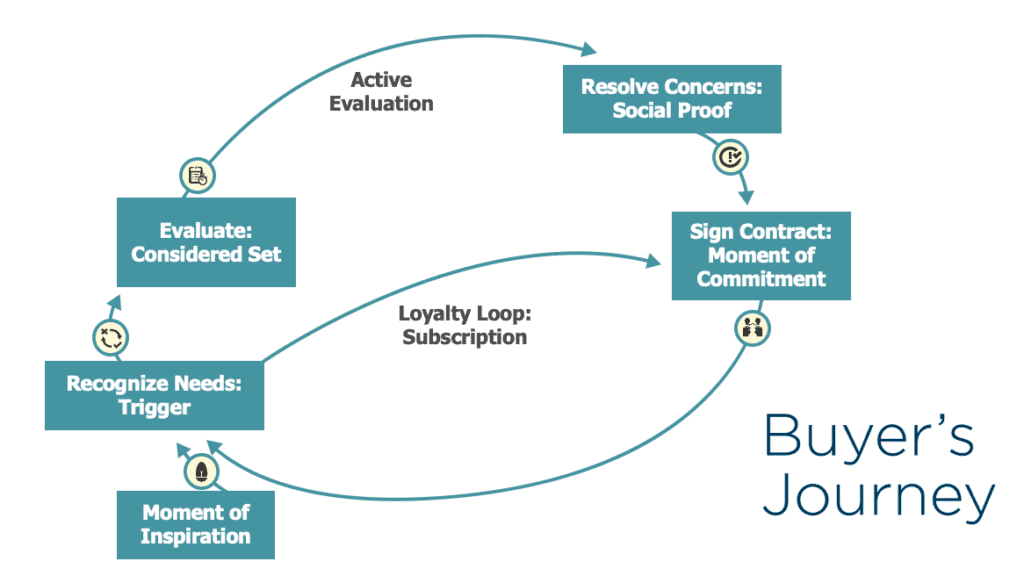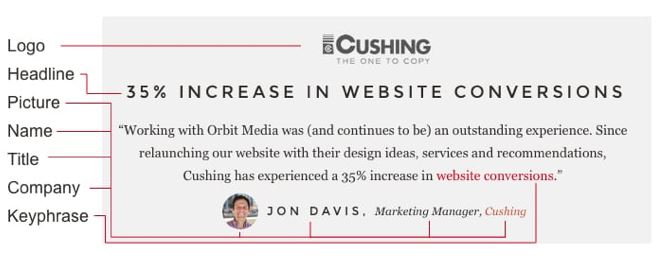
“How do you ensure that your testimonials contribute to your content marketing messaging?”
Testimonials in content marketing: How do you ensure that your testimonials contribute to your content marketing messaging?
This question, one of the Top 100 Questions on content marketing, comes from a marketer at City National Bank.
In the eyes of buyers, testimonials are absolutely essential.
Without them, buyers can’t complete all the steps in the buyers’ journey for a carefully considered purchase. Many buyers skip over brands that lack testimonials or social proof.
Why do people seek out customer testimonials?
In choosing a bank or making any carefully considered purchase, buyers take 4 steps during the buyers journey. In step 3, customers specifically seek social proof such as a testimonial or review to resolve their concerns.

Here are the first 4 steps in a buyers journey on a carefully considered purchase:
1.) Identify need: Buyers discover an unmet need. Their discovery triggers the beginning of the buyers journey.
2.) Evaluate options: Buyers consider their options – such as to choose a bank, a credit union, or another type of financial institution. Buyers evaluate a set of brands that they think can meet their needs – known as the considered set.
3.) Seek social proof: Before reaching a decision, buyers seek third parties who assure them they’re making a good call. Third-party social media, rankings, ratings, and testimonials provide social proof, enabling buyers to move forward to a conclusion.
4.) Complete purchase: Buyers choose a seller, make a decision, and finalize the deal.
Third-party social proof like testimonials ought to be in a buyer’s own words.
Those words are not necessarily the same words that a brand would use to script an actor in a TV commercial. Good testimonials feel and sound more real and authentic than a script.
For example, one customer testimonial on our home page reflects a client’s skepticism — which a scripted piece of content would never do.
“Best content marketing training I’ve had so far – and I’m not easy to impress. 😉 Thanks for sharing your expertise with our teams,” said Crystal (Audrick) Files, AVP-Marketing at Nationwide.
Such skepticism can make your social proof even more believable — since it’s real and authentic.
To gain alignment between what happy customers say in a testimonial and your content marketing message:
- Always speak your customers’ language. Recognize the value of listening to, understanding, and using real words that real customers use.
- Align your brand promise and message with the customer experience, so customers reinforce your message when they talk about their experiences. To deliver a delightful experience, deliver what you promised – plus a little more than people expect.
- Remember that customers are looking for social proof that comes from experts and people like themselves. If you sell to multiple segments of customers, make sure all segments are represented in your testimonials.
- Don’t crowd all your testimonials onto one webpage. Spread them around your website for maximum visibility. Use them in public relations, emails, social media, videos and presentations.
- To make your website testimonials even more visible and powerful, apply the testimonial template from Andy Crestodina at Orbit Media. It highlights the company logo; puts a benefit in the headline; shows who is speaking with a photo, name and title; and uses a keyword to drive search engine optimization (SEO).
Testimonials in content marketing

To really drive home your customer’s point, make your happy customer’s photo even bigger.
In an A/B test that pitted a text-laden testimonial webpage against a testimonial that features a customer photo and quote, Highrise got a 102.5% lift with the customer photo approach.
What’s more, paid sign-ups from the page increased 47%.

Who should you ask for testimonials? When?
First, approach each of your super-fans for a testimonial, one by one.
Suggest a topic for them. Ask them to write a testimonial if they’re comfortable doing so. Or interview them to get a testimonial in writing.
Next, monitor emails, social media, and phone calls for positive customer feedback. Make it easy for customers to say yes by sending the quote for approval by email.
Ask for testimonials at the right moment: when you’ve successfully completed a project or delivered a good experience.

“How do you ensure that your testimonials contribute to your content marketing messaging?” is one of the Top 100 Questions on content marketing. Here are the answers.





